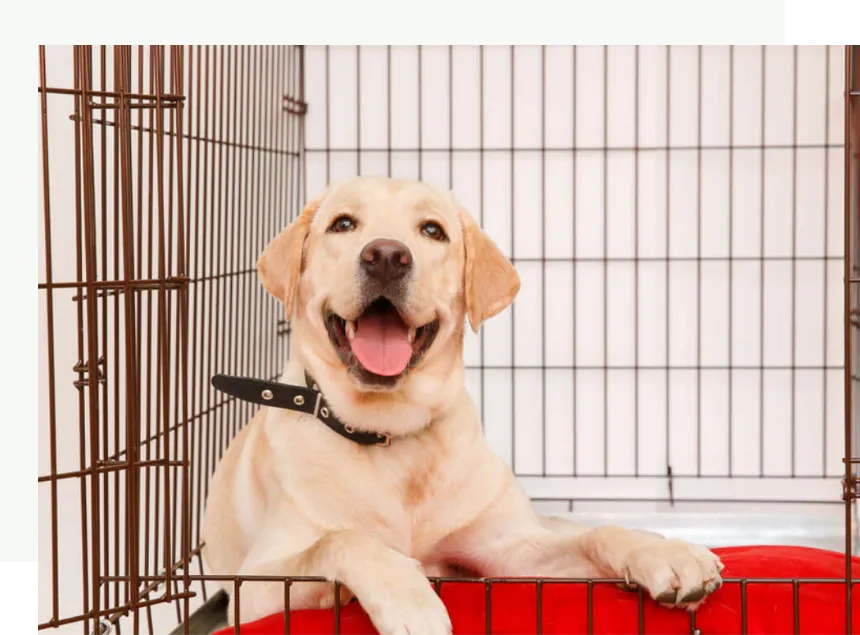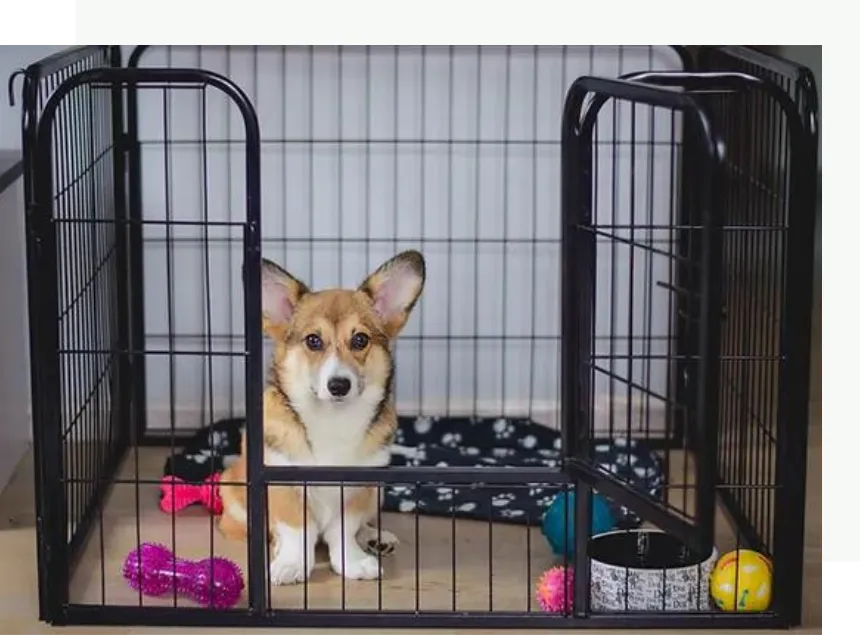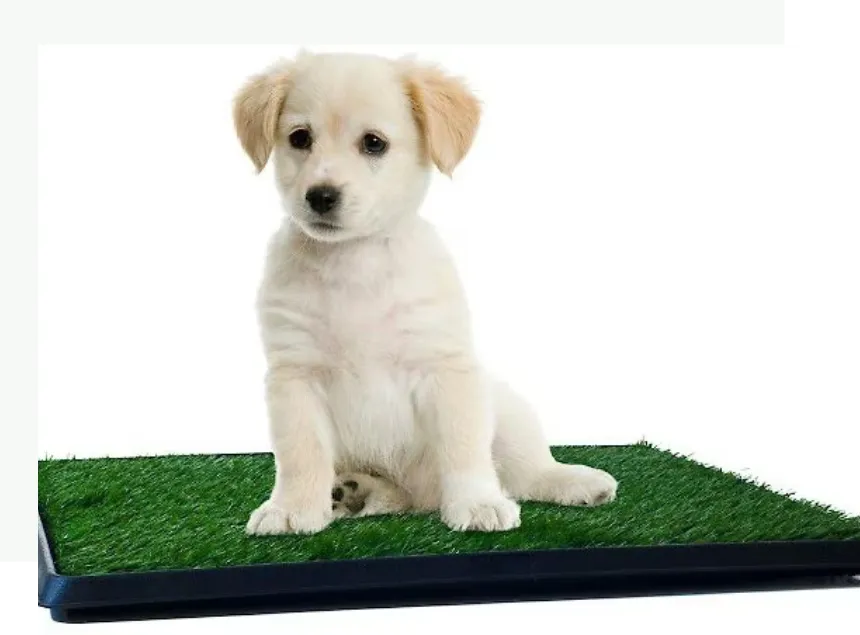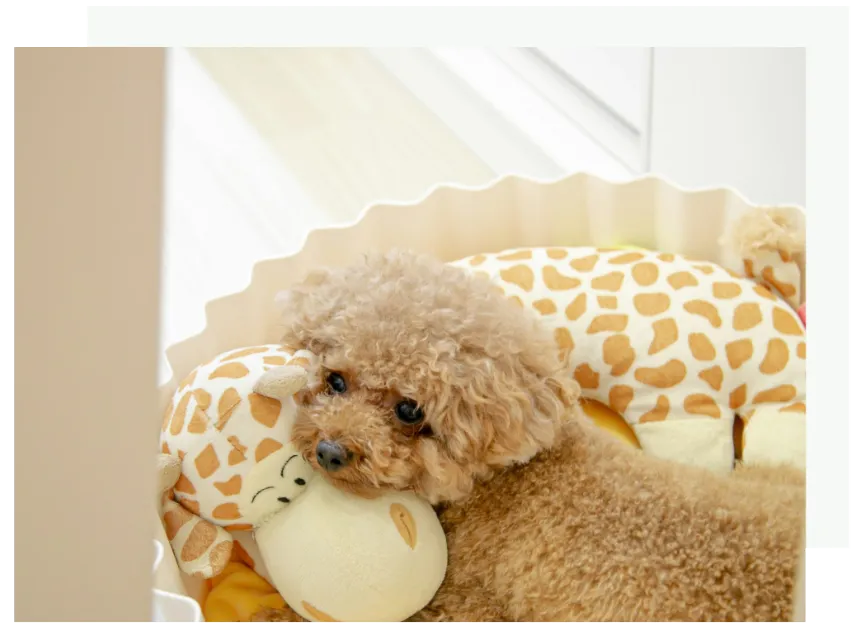Located in Bellevue, serving Seattle Metro, the Eastside Communities and King County
Sleeping and Containment
Sleeping and containment arrangements for your puppy are an important consideration for all new puppy owners. Just like a human child, puppies need a safe and comfortable place to sleep and play.
Don't for one minute think that you can safely give your puppy unrestricted access to your home! Their safety (and your sanity) demands some level of containment.
Crates, Pens, or ...?
Lets look at the options so you can create the best indoor environment for your puppy.

Benefits of Crate Training
Safety
Puppies are loveable and full of mischief, in equal measure! Puppies have a special talent for ferreting out your favorite pair of shoes to chew on. And they especially love to swallow your socks or underwear (I know, they're gross). They also love to chew on wood furntiture and electrical cords, grab food off the counters and go dumpster diving. Oh, and your kids' favorite toys? Your new glassses? That too.
Nothing is off limits to a puppy! Your puppies crate or pen is a safe place that will ensure they don't run around getting into all kinds of trouble, like chewing up everything they can get their paws on.
House (Potty) Training
The fastest, most reliable way to successfully house train your puppy is to utilize a crate. Consistency is key! Mother Nature has instilled instincts in your puppy to prevent them from soiling their sleeping space. IF you are careful to take your puppy out for regular potty breaks, and supervise carefully to ensure they GO, the puppy will be reluctant to go inside their crate. For more information, see our section on House Training.
A place to sleep, relax, decompress and recuperate
Puppies need a great deal of sleep, or they become tyrants, much like toddlers. Regular naps help them grow, learn and develop into a well-adjusted adult dog. Without adequate downtime they can become overstimulated and stressed. The busier the household, the more benefit the crate will be to you and your puppy. When life gets hectic, with kids, household visitors and such, it's a welcome relief for your puppy to have someplace to retreat to where they can enjoy their own space.
There will be times your pup may be ill or injured or recovering from a surgery, either at home or at the vet. If your puppy is comfortable and accustomed to resting in their crate it will be of great benefit to them as they recover.
Prevent destructive behavior
They love to chew on wood furniture and electrical cords, grab food off the counters and go dumpster diving. No one can supervise all the time. Containment reduces the opportunities for your dog to destroy your belongings and earn bad habits. No matter what age, your dog can decide that while you are in the other room or out for the night, he will enjoy food left out or gnawing on the leg of your kitchen table.
Travel and emergencies
A crate trained dog is a dog that can travel with you and enjoy safety and security that isn't possible otherwise. Especially for long distance road trips, a crate is the safest place for your puppy!! Your crate trained puppy is much more likely to be welcomed by family and friends, pet friendly hotels, and vacation rentals. In the event you need to flee your home due to an emergency, your crate trained dog is much more likely to be accepted into a temporary shelter than a dog that freaks out in a crate.
Behavior modification, new dog introductions
For many situations, crates are hugely helpful, and even essential, to safely manage multiple dogs in the household.
For example:
Bringing a new puppy into the home is a classic example. Don't allow your new puppy to pester your older dog without mercy. Both your puppy and your other dog need to have their own space at times, and they need to be introduced carefully and gradually. Crating them in close proximity can help them get comfortable with each other more quickly.
Dogs with behavior issues or possible aggression, should be rotated (one dog out, the other in) for the first few days/weeks as you take your time you time to assess the best way to move forward.
Foster dogs or any new dog needs a safe, quiet space for a few days before they are required to interact directly with others-dog or human.When Can I stop Using The Crate?
Don't be in a rush to ditch the crate. We recommend that you not leave your dog home alone unless they are crated for at least the first year. This is your best insurance against damage to property, your dog ingesting something harmful, and/or behavior issues such as separation anxiety.
By eliminating the opportunity to practice undesirable behaviors while you’re gone, many things will never become an issue at all and they will become conditioned to simply relaxing when you’re away. Once they're older, leave their crate open and available and you'll likely find them going in on their own when they want some quiet time. Maintaining the crate as a place where they feel safe and comfortable is an important life skill for a dog living in our modern world.
Crate or a Pen?
Ideally, it's nice to have both, if your space and budget permits. Crates work best for sleeping at night, napping during the day and when no one is home. Pens are nice for more active times when you're home and you want to give your puppy a bit more freedom to roam and play while still maintaining safety and limiting their ability to get into trouble.
The pen should be setup to allow for 4 distinct zones:
Food and water
Play area
Sleep area (with a crate or bed)
Food and water
DISCLAIMER: Don't leave your dog alone for too long, always be sure someone is available to give them their walks, potty breaks and meals.

Don't waste money on expensive bedding right now. Your puppy will likely chew up a stuffed bed. chooses somethiing absorbent in case of accidents, an old towel or a flannel blanket is fine. Click here for more information aabout puppy friendly bedding options.

My preference would be that puppies NEVER go inside the house, anywhere. But sometimes it just isn't entirely practical, especially if you live in an apartment.
If you decide to include a potty area in the pen, make sure that it's very defined as a separate space and as close as possible to the same surface you want them to go on outside.
This is SUPER important! Puppies develop a distinct preference for going on a particular type of surface and it can be difficult to transition them to going outside as they grow if they are trained to go on paper or a different type of surface than they would find outside.
The best alternative is a potty system with real grass or fake grass. There are a bunch to choose from, my favorite is real grass from the local garden store cut to fit. A puppy litter box with pine pellets or beet pellets (you can get these at a feed store) works well, too.
Make sure the sleeping area is well defined as a separate area. You can put a crate inside the pen, or a raised cot so that your dog is less likely to use their bed as a potty space.

Puppies Need a Schedule
Establishing a routine schedule for your puppy is an important part of raising a happy and healthy puppy. Creating a predictable structure for your day will help your puppy feel secure as he learns what's expected of him in his new home. Create a schedule and stick to it!
Everyone will benefit from this, not just the puppy. You can make appropriate adjustments as your puppy grows. The first few weeks with your new puppy is the time to start establishing good behavior patterns.
You won’t have to plan out every moment of your pup’s day, but there are a few important areas where a schedule can make the difference between a well-adjusted dog and chaos.
Feeding Schedule
Three meals a day is recommended for the first 4-6 months. Planning mealtimes that correspond to your own will make it easy to remember, however once you start formal training, you can use part of their daily meal portions as training rewards.
Potty Breaks
For successful potty training, it's essential that you take your puppy out at age appropriate intervals and supervise them carefully to be sure they go. In general, figure 1 hour for every month of age. If possible, take them out on leash at times and off leash at other times. Some dogs become quite picky about how and where they eliminate. Teach your puppy while they are young to be flexible and to go potty anywhere, on command, and reward them!
Structured Activities
Training!! Also walks, tug, fetch and similar activities. These activities all need to be initiated by you.Your puppy needs a combination of play, mental stimulation, and age appropriate exercise to thrive. When making your own schedule, make sure to fit in at least two to three activity times during the day, including active training sessions. Be alert to take advantage of passive training opportunities at all times. Work in several sessions of teaching a new skill or building reliability for skills they already know. These sessions should be very SHORT, 3-5 minutes each for puppies, no more than 10-20 minutes for older puppies. Also be sure to include socialization activities in their day.
Caution: experts recommend waiting until a dog is about one year old before starting with heavy exercise activities. This can vary by breed, different dog breeds have different energy levels and rates of growth; the growth plates in their joints close at different ages.
Nap Time!
Just like a human baby, young puppies need to sleep... a lot. Depending on their age18-20 hours a day, on average. Growing is hard work for their young bodies! When puppies don't get enough rest it often shows up in frantic, out of control behavior, especially later in the day. Make naptime a regular part of their routine, it's just as important as feeding and activities for a happy, well adjusted puppy. You may want to put their crate in a part of the house that's quiet and allows them to settle down more easily.
Sleeping Guidlines
Here's a guide to help you gauge how much rest your puppy needs by age.

8 to 17 Weeks Old
18 - 20 Hours
For optimal physical and mental development, very young puppies need a series of short 15 to 20 minute naps interspersed with longer naps, up to 3 hours, throughout the day.
17 to 30 Weeks Old
14 - 17 Hours
As your puppy grows they won't need as many short naps, but will still need a few longer naps during the day.
30+ Weeks Old
12+ Hours
As your dog becomes an adolescent, they'll still need regular rest periods. How much will be determined more by their breed and activity level than by their age at this point. Be sure to give your dog nap time as needed.
Sample Schedule
This is a very basic sample of the program provided in our Board and Train and Day Training programs. This is just a sample and can be adapted in many ways to fit you and your dog’s needs. Younger puppies need more frequent potty breaks, shorter activity times and short power naps in addition to longer crate rest time.
First thing in the morning, out of crate to go potty.
Feeding and 30-60 minutes structured activity followed by supervised free time (for very young puppies, take out for a second potty break in 15-20 minutes).
Naptime in crate for 1- 2 hours.
Lunch Time
Out for potty break, followed by 30-60 minutes structured activity and supervised free time.
Naptime in crate for 1- 2 hours.
Out for potty break, followed by 30-60 minutes structured activity and supervised free time.
Feeding.
Last potty break. Create a calming training ritual to prepare for back into crate and lights out.
SERVING
The Greater Seattle Metro Area
Bellevue
Issaquah
Mercer Island
Kirkland
Redmond
Renton
Newcastle
FROM PUPPIES TO ADULTS
- Obedience
- Good Manners
- Off Leash Training
- Behavior Modification
- Fear and Anxiety
- Reactivity and Aggression
- Destructive Behavior
- Boundary Training

